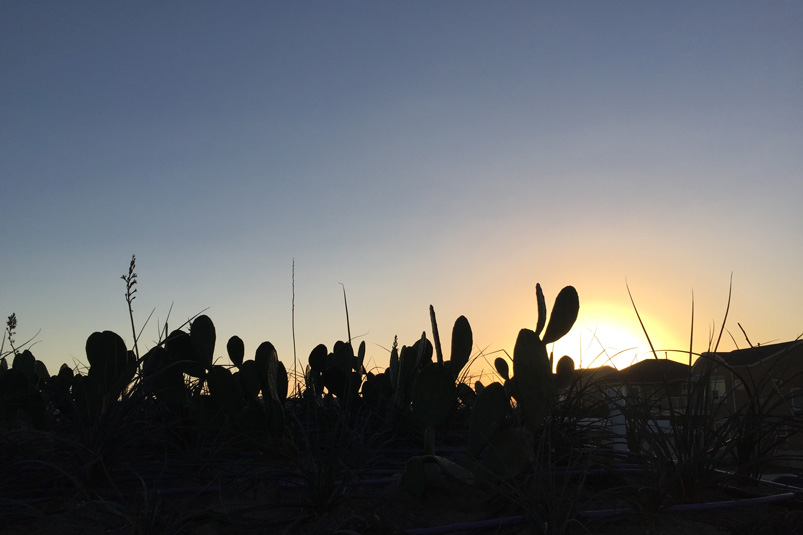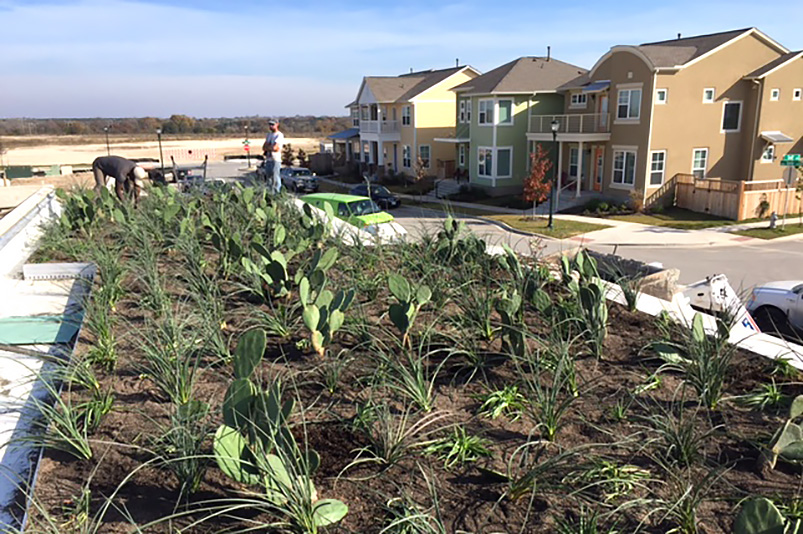Installing a Sky Garden

A NEW GARDEN IN THE SKY IS GROWING atop a bathing pavilion in John Gaines park in the award-winning Mueller planned community in Austin. Prickly pear (Opuntia ellisiana), red yucca (Hesperaloe parviflora), manfreda (Manfreda maculosa), bluebonnets (Lupinus texensis) and more crown the 1200-square-foot green roof, which will be irrigated solely with harvested rainwater. The park includes a pool, active play areas and community vegetable gardens.
This rooftop garden was designed by Wildflower Center staff in collaboration with Stanley Studio, and uses SkySystem™, a growing medium created by the Center’s Ecosystem Design Group for use with green roofs in semi arid climates. The roof is also the first project outside of the Center to use a specially formulated succulent plant mix. More than 800 native plants, from one to three gallons in size, were planted on the roof, as well as seeds of carefully selected wildflowers.

The newly planted green roof at a community pool in the growing Mueller Austin neighborhood features native plants such as prickly pear and red yucca and will provide habitat for wildlife and filter water. PHOTO John Hart Asher
In the near future, the succulent mix and growing media will top a green roof at The University of Texas at Austin Dell Medical School. These two roofs join several others that have been installed throughout Austin featuring various plants native to Central Texas.
Projects like these, from large to small scale, will help transform our city.
All together the projects, along with the multi-acre Southwest Parkway that the Center helped establish at Mueller in 2008, seek to restore the Blackland Prairie, one of the the most endangered habitats in North America, within Austin’s urban environment. Blackland prairie once stretched from central to north Texas over an area of more than 15,000,000 acres. Today, less than one percent remains.
“Projects like these, from large to small scale, will help transform our city, an environment generally seen as the antithesis of natural process, into a thriving novel ecosystem that helps restore this endangered habitat,” says John Hart Asher, M.L.A., environmental designer. “If we create a little bit of habitat here, and some more habitat there, we can make a big difference. We’re not going to attract megafauna like bison that need large tracts of habitat, but these environments are extremely important for smaller native animal species such as pollinators.”
He says green roofs provide other benefits as well:
- They slow the flow of rainwater from a site, reducing flooding caused by flash flood events.
- They reduce the building’s heat load that spikes air conditioning bills.
- They filter the air, removing carbon and other pollutants.
- They can actually outlast traditional roofs, because the plants protect the building materials from the elements.
“They won’t singlehandedly solve all the challenges of living in a hot climate or reduce global warming, but they’re one of many activities that will help,” says Asher.
Discussions are now underway to make the patented SkySystem™ growing media available commercially.
Related Stories:

